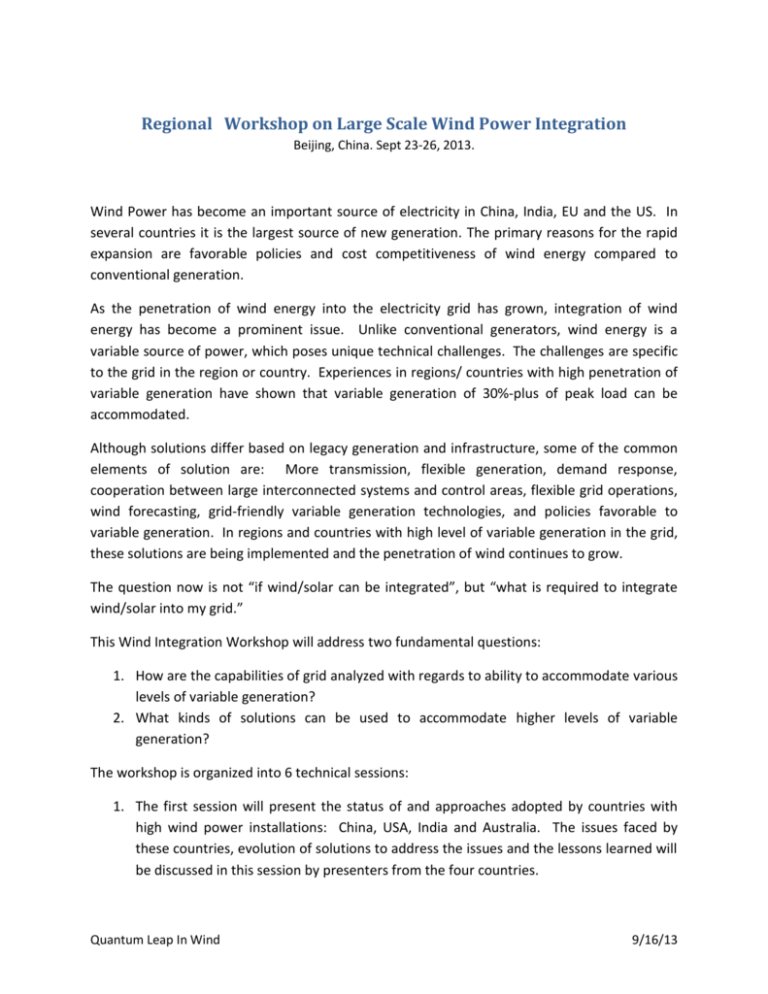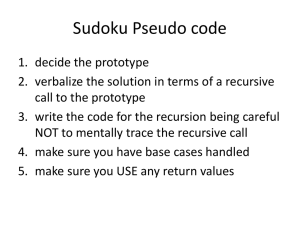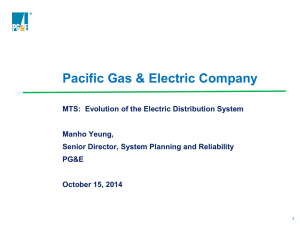Workshop Objectives
advertisement

Regional Workshop on Large Scale Wind Power Integration Beijing, China. Sept 23-26, 2013. Wind Power has become an important source of electricity in China, India, EU and the US. In several countries it is the largest source of new generation. The primary reasons for the rapid expansion are favorable policies and cost competitiveness of wind energy compared to conventional generation. As the penetration of wind energy into the electricity grid has grown, integration of wind energy has become a prominent issue. Unlike conventional generators, wind energy is a variable source of power, which poses unique technical challenges. The challenges are specific to the grid in the region or country. Experiences in regions/ countries with high penetration of variable generation have shown that variable generation of 30%-plus of peak load can be accommodated. Although solutions differ based on legacy generation and infrastructure, some of the common elements of solution are: More transmission, flexible generation, demand response, cooperation between large interconnected systems and control areas, flexible grid operations, wind forecasting, grid-friendly variable generation technologies, and policies favorable to variable generation. In regions and countries with high level of variable generation in the grid, these solutions are being implemented and the penetration of wind continues to grow. The question now is not “if wind/solar can be integrated”, but “what is required to integrate wind/solar into my grid.” This Wind Integration Workshop will address two fundamental questions: 1. How are the capabilities of grid analyzed with regards to ability to accommodate various levels of variable generation? 2. What kinds of solutions can be used to accommodate higher levels of variable generation? The workshop is organized into 6 technical sessions: 1. The first session will present the status of and approaches adopted by countries with high wind power installations: China, USA, India and Australia. The issues faced by these countries, evolution of solutions to address the issues and the lessons learned will be discussed in this session by presenters from the four countries. Quantum Leap In Wind 9/16/13 2. The second session will present long-term strategic system-wide analysis to determine the requirements in order to achieve higher penetration of variable generation. It will discuss the methods/tools used for analysis, the outcome/revelations of the analysis and the proposed solutions. Experiences in various markets including US and China will be presented. The following questions will be answered: What is the acceptable level of penetration of wind power into a grid? What factors determine the level of penetration—Why are some grids able to absorb higher percentage of energy from wind? How can the level of penetration of wind power be increased? What is the cost of higher levels of penetration of wind? 3. The third session will focus on grid code for interconnecting variable generation. It will describe experiences with various elements of the grid code in different markets. The current status of grid code in China, its shortcomings and proposed improvements will be presented. The following questions will be answered: What are the requirements to make wind power plants grid friendly? What power quality issues must be addressed by wind energy? What types of data should the wind plants provide to dispatch center? 4. The fourth session will present the system impact studies for proposed wind farms. These studies are performed to understand the impact on reliability, safety and stability of the power system due to injection of variable power at a specific point of connection. The methodology, data requirements, output and limitations of the studies will be presented. The following questions will be answered: What is the impact on system stability due to wind power? What is the impact of rapid ramping up or down of wind energy generation on the grid? How is the power flow in a grid impacted with high wind energy production and low demand? What changes must be made to the grid to accommodate wind energy? 5. The fifth session will present operational matters related to dispatching variable generation. Methods for managing day-, hour- and minute-level scheduling with variable generation will be presented. Experiences of wind power dispatching in US and China will be discussed. The following questions will be answered: Is wind energy dis patchable? What methods are used by grid operators to schedule wind into in 24-hour, and hour-to-hour time window? How well can wind energy be forecasted? How much spinning reserves are needed to support variability of wind energy? 6. In the sixth session, emerging technologies and methods related to integrating variable generation into the grid will be presented. Role of storage technologies, wind energy forecasting and advances in control technologies will be discussed in this session. Quantum Leap In Wind 9/16/13









